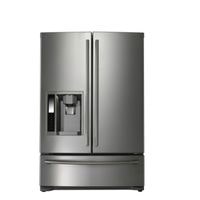Whirlpool refrigerator troubleshooting. You might be experiencing a common Whirlpool refrigerator problem, like the freezer isn’t freezing or some other temperature-control issue.
In this case, the fix may involve closing the door completely and ensuring that it locks into place properly or simply resetting your defrost timer.
However, you could have a more serious problem on your hands. Maybe there’s ice accumulation in your freezer, and water is leaking onto the floor, or else your refrigerator just won’t stop running.
The good news is you’ve come to the right place for understanding refrigerators and resolving these issues.
Whirlpool refrigerator troubleshooting
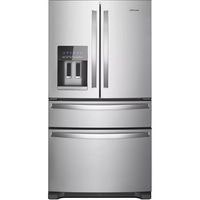
A working refrigerator helps keep your family (and your food!) well-fed and enjoying healthy meals. But when something goes wrong, you may feel like it’s an emergency.
Here’s how to identify the root cause of refrigerator troubles. Rooting out the source of electrical problems will help you save money by ditching costly service calls (and avoiding replacing an entire appliance). No time to read now? Check out our infographic instead.
Condenser Coils are Dirty
When the refrigerator is malfunctioning, often the first thing to check is whether or not the coils are dirty. The condenser coils are located outside of the refrigerator, usually on the back along the top, depending on your model.
They are very important in helping to ensure that your unit works effectively by dissipating excess heat away from inside the fridge. To see if they are indeed dirty, look for buildup around or on them.
If you find any debris after your inspection, don’t clean it with water immediately, as this may further damage them! Instead, try using a can of compressed air to blast off any bits of dirt and dried food particles first.
Condenser Fan Motor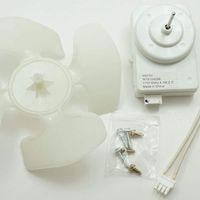
The refrigerator’s condenser fan motor absorbs the heat from inside the appliance and then blows it into the outside air using a steady stream of air.
If this vital component of the machine is misfiring, your fridge will stop working correctly.
One way to detect whether a problem with a fan motor is occurring is by checking its blade for damage or obstruction. Potentially loose parts can be removed from circulation or even bent back into position.
Also, try turning the blades manually to see if anything gets stuck inside – given enough time, you might even be able to fix it yourself! Advanced users should also consider testing for continuity between the three-pronged plug at the base of a fridge’s fan motor and its main circuit board.
Start Relay issue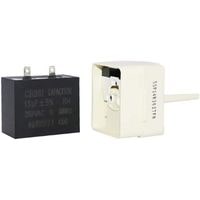
The start-pick relay must work in conjunction with the start winding to begin working. A faulty start relay will sometimes prevent the compressor from running or not running at all.
As a result, the refrigerator won’t be cold enough. To determine if it is indeed bad, use a multimeter to test it for continuity between the run and start terminal sockets.
If there is no continuity between them, replace it. As an extra precaution, we recommend testing for moister, too, for starters.
If you see that there’s something burning or that there’s smoke coming from it, then you need to replace it right away because chances are high that short circuits and thermal overloads may occur, and this can lead to serious melting and catching fire!
Defective Temperature Control Thermostat
The temperature control thermostat directs energy to the entire refrigerant system. If something were to happen to go wrong with this part, there would be no way for the entire refrigerant system to function properly.
So if your thermostat ever stops functioning along with your cooling and heating system, you need to know how to tell if it’s time to replace it.
It should click into place at any temperature setting; if it doesn’t, then that means that there is something defective with that particular thermostat. Make sure the room temperatures are accurate before pressing any buttons on your thermostat.
The best way to test this is through the use of a multimeter since checking continuity will be the first step in determining whether or not this part needs replacement.
Faulty Compressor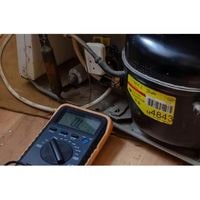
The compressor is a crucial part of the refrigerator that ensures the refrigerant flows freely to the evaporator, condenser, and back into your kitchen.
Frost builds up, or ice can build up on the coils affecting the functionality of the refrigeration system. If your refrigerator seems to be malfunctioning, there are a few easy diagnostic tests you can perform before calling the professionals out to take a look at it for you.
Measure across each terminal lead from left to right with a multimeter set to ohms resistance mode. If you have a reading between 0-1Ω, replace the compressor.
Start Capacitor problem
If the start capacitor isn’t working, you might know that it not only means your refrigerator will not cool but also that your compressor will not start. In this case, there are a few things you can do.
For starters, you may consider opting for a replacement. One of our experts at Pacific Sales Service says that before starting with the replacement process, you may want to test out the current capacitor using a multimeter.
If this results in a malfunctioning reading, then you know it’s time to purchase a new one and replace it. Remember to be safe when messing with any of these components Unplug the appliance or disconnect supply power from the unit before making any repairs.
Temperature Control Board
The temperature control board is found in the AC unit of your home. This component receives instructions from the thermostat about how to regulate air conditioner operation.
The temperature control board sends this information to the compressor so it can activate its heating cycle. If the temperature control board has gone bad, it will not be able to send adequate instructions to the compressor so the entire AC system will fail in cooling your home’s interior.
Before replacing this board, first test all of the other components that are known to be faulty on this type of car because they are more likely to actually cause the malfunction.
If none of these components are faulty, then replace the temperature control board or at least have it professionally checked out or repaired if you’re unable to find someone who can work on it yourself.
Main Control Board
The main control board is almost never the problem. However, before replacing it, test all of the following parts: microcontroller, power supply, motor control board, and any external to the pool pump such as temperature sensors or flow controls.
If you confirm that none of these parts are defective, confer with the pool pump’s manufacturer to see if this is a common problem with your model in general, and try replacing just the main control board instead.
Related Guides
